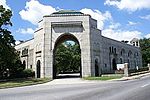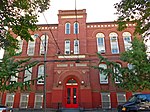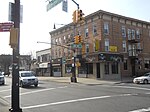Beth Olam Cemetery

The Beth Olam Cemetery is a historic cemetery in Cypress Hills, Brooklyn, New York City. It is located in the city's Cemetery Belt, bisected by the border between Brooklyn and Queens. It is a rural cemetery in style, and was started in 1851 by three Manhattan Jewish congregations: Congregation Shearith Israel (Spanish Portuguese) on West 70th Street, B'nai Jeshurun on West 89th Street, and Temple Shaaray Tefila on East 79th Street. In 1882, Calvert Vaux was commissioned to design a small, red brick Metaher house or place of purification and pre-burial eulogies, near the entrance to the Shearith Israel section. It is the only religious building that Vaux, the co-designer of Central Park, is known to have designed. The burial ground contains many examples of architecture and funerary art.
Excerpt from the Wikipedia article Beth Olam Cemetery (License: CC BY-SA 3.0, Authors, Images).Beth Olam Cemetery
Cypress Hills Street, New York Brooklyn
Geographical coordinates (GPS) Address Nearby Places Show on map
Geographical coordinates (GPS)
| Latitude | Longitude |
|---|---|
| N 40.690555555556 ° | E -73.88 ° |
Address
Cypress Hills Street
Cypress Hills Street
11208 New York, Brooklyn
New York, United States
Open on Google Maps










